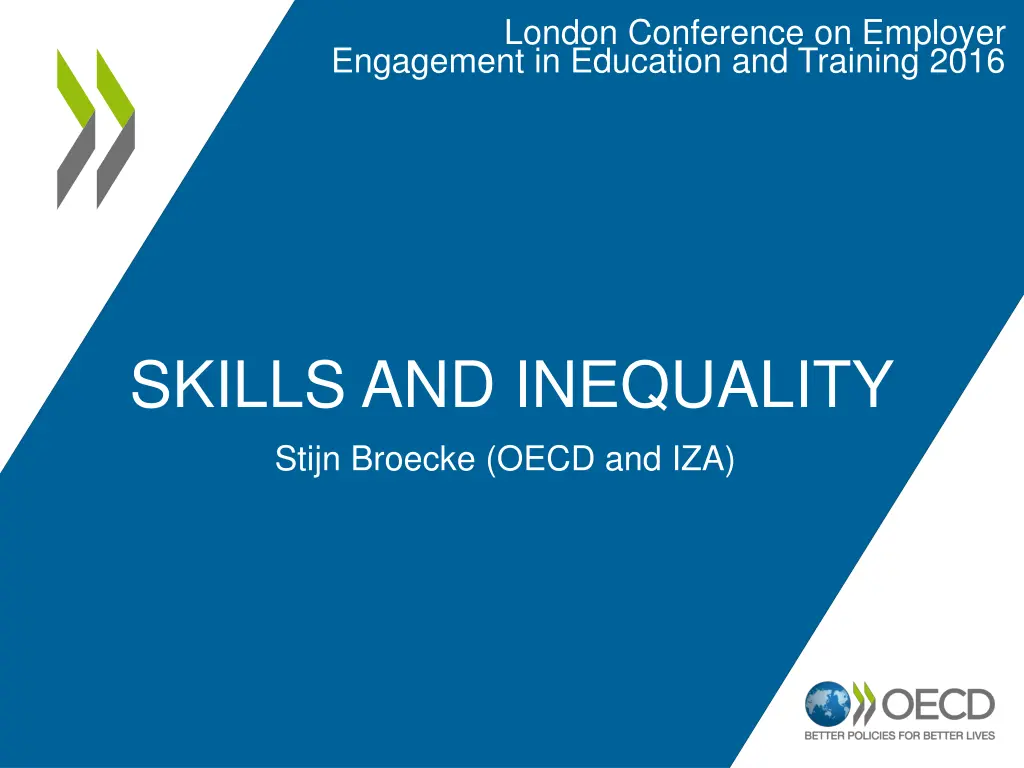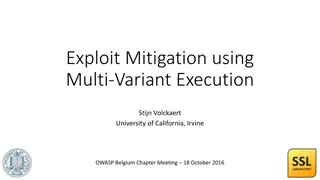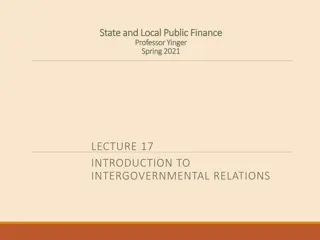
Understanding Inequality and Its Impact on Skills and Society
Explore the causes and consequences of inequality, particularly in relation to skills and societal outcomes. Learn about the economic and social costs of inequality, along with the factors contributing to its rise. Discover the connection between changing skills needs and the evolving landscape of technological advancements. Gain insights into the rich literature linking inequality with the demand for various skill sets, shedding light on the complexities of today's workforce dynamics.
Download Presentation

Please find below an Image/Link to download the presentation.
The content on the website is provided AS IS for your information and personal use only. It may not be sold, licensed, or shared on other websites without obtaining consent from the author. If you encounter any issues during the download, it is possible that the publisher has removed the file from their server.
You are allowed to download the files provided on this website for personal or commercial use, subject to the condition that they are used lawfully. All files are the property of their respective owners.
The content on the website is provided AS IS for your information and personal use only. It may not be sold, licensed, or shared on other websites without obtaining consent from the author.
E N D
Presentation Transcript
London Conference on Employer Engagement in Education and Training 2016 SKILLS AND INEQUALITY Stijn Broecke (OECD and IZA)
The gap between rich and poor is at its highest for 30 years, with the top 10% now earning 9.6 times more than the poorest 10%
Economic cost of inequality Earlier arguments: inequality = necessary evil in the pursuit of economic growth (Kaldor, 1957, Kuznets, 1955, Mirrlees, 1971; Lazear and Rosen, 1981) More recently: inequality reduces growth: Redistributive pressures (Persson and Tabellini, 1994; Alesina and Rodrik, 2014) Generates social conflict (Benhabib and Rustichini, 1996; Perotti, 1996) Prevents the talented poor from undertaking profitable investments in physical and human capital (Galor and Zeira, 1993; Banerjee and Newman, 1993) Catalyses financial crises (Rajan, 2010)
Social costs of inequality Lower social and inter-generational mobility (Krueger, 2012) Health and social problems (Pickett et Wilkinson, 2011) Higher crime (Fajnzylber et al., 2002) Weaker social cohesion and trust (Brown et Uslaner, 2002)
Causes of inequality Globalisation Technological change Regulations/institutions Skills Changing family structures Non-wage incomes Tax and benefit systems
Rich literature showing the link between inequality and changing skills needs Skills-biased technological change: rising inequality linked to the fact that the supply of educated workers has not kept pace with the rise in demand for them (Juhn, Murphy and Pierce, 1993; Juhn, 1999; Goldin and Katz, 2008; Autor, 2014) More recent theories of routine-biased technological change maintain a central role for skills in explaining rising wage inequality in the United States (Autor, Levy, and Murnane, 2003; Autor, Katz, and Kearney, 2006, 2008; Autor and Dorn, 2013; Autor, 2015) Other explanations for changing demand for skills: Offshoring (Blinder, 2009) Population ageing (Dwyer, 2013) Organisational changes (Acemoglu, 1999; Bresnahan et al., 2002; Caroli and van Reenen, 2001, Antr s et al., 2006)
But cross-country studies suggest skills matter little to inequality Cross-country differences in wage inequality: Paper Data Method Do skills matter? Devroye and Freeman (2001) IALS Variance decomposition No Blau and Kahn (2005) IALS JMP decomposition No Leuven et al. (2004) IALS Katz and Murphy D&S analysis Yes Jovecic (2015) PIAAC Variance decomposition No Pena (2015) PIAAC JMP decomposition No Paccagnella (2015) PIAAC Unconditional quantile regressions No Machin et al. (2016) PIAAC Unconditional quantile regressions No
Survey of Adult Skills (PIAAC, 2012) 166 000 adults (aged 16-65) from 24 countries Tested in literacy, numeracy and problem solving in technology-rich environments Also: individuals skills use in the workplace, labor market status, wages, education, experience, and a range of demographic characteristics Samples range from around 4 500 in Sweden to nearly 27 300 in Canada (5 100 in the UK)
Wage inequality varies across countries Wage inequality in PIAAC countries (wage ratio D9/D1) 6 5 4 3 2 1
Countries differ also in the level and dispersion of skills Mean numeracy, 10th and 90th percentile for the employed population P90 P10 mean 375 355 335 315 295 275 255 235 215 195 175
The relationship between skills inequality and wage inequality is not straightforward 1.8 USA 1.8 FRA Skills inequality (D9/D1) 1.7 ITA CAN 1.7 GBR ESP DEU 1.6 AUS IRL NOR POL SWE BEL 1.6 AUT NLD DNK FIN KOR 1.5 EST JPN CZE 1.5 SVK 1.4 1.0 2.0 3.0 4.0 5.0 6.0 7.0 Wage inequality (D9/D1)
Simulate wage distributions using reweighting techniques Actual PIAAC skills 0.9 0.8 0.7 0.6 0.5 0.4 0.3 0.2 0.1 0 1 1.5 2 2.5 3 3.5 4 4.5 5
The impact of skills inequality on wage inequality Percentage change in wage inequality (P90/P10) as a result of moving to the average PIAAC skills inequality 4 3.6 3 2.1 2 1.4 1.2 1 0.4 0.4 0.4 0.3 0.0 % 0 0.0 -0.1 -0.1 -0.2 -0.5 -0.5 -0.5 -0.5 -1 -0.7 -0.7 -0.9 -2 -1.6 -3 -4 -4.0 -5
Differences in return to skill are far more important Percentage change in hourly wages for a one standard deviation increase in numearcy 25 20 15 10 5 0
And the return to skill has a far more important impact on wage inequality Percentage change in wage inequality (P90/P10) as a result of moving to the average PIAAC return to skill 8 6 4 3.2 3.0 2.2 1.8 2 1.2 0.5 0.1 0 -0.4-0.1 -1.9-1.6-1.2 -1.2-0.9 -2 -4 -4.3 -6 -5.2 -6.7 -6.7-6.5-6.0 -8 -8.5 -8.3 -10
The return to skill is determined in part by labour market institutions, policies and practices Minimum wage DiNardo et al., 1996 ; Lee, 1999 ; Wolff, 2008 ; Autor et al., 2014 ; Machin, 1997 ; Dickens et al., 1999; Koeniger et al., 2007 Collective bargaining coverage Braconier et Ruiz-Valenzuea, 2014 ; Blau et Kahn, 1996 ; DiNardo et al., 2007 ; Wolff, 2008 ; Firpo et al., 2011 Employment protection legislation OCDE (2015) Practices around bonus pay Lemieux et al., 2007 Size of the public sector Generosity of unemployment benefits
The return to skill (and inequality) also depend on the supply of, and demand for, skill Country Australia Austria Canada Czech Republic Denmark England/N. Ireland (UK) Estonia Finland Flanders (B) France Germany Ireland Italy Japan Korea Netherlands Norway Poland Slovak Republic Spain Sweden United States Low 34.3 28.0 36.5 26.7 26.8 39.7 28.8 24.7 25.7 43.8 31.9 42.5 50.9 18.7 35.5 24.6 26.3 40.0 26.1 50.1 25.6 45.8 Medium 32.2 35.2 31.4 38.1 32.7 31.1 37.9 31.7 32.1 31.0 31.5 34.1 31.4 33.9 38.7 32.1 32.1 34.5 36.3 33.1 32.3 29.6 High 33.4 36.9 32.0 35.2 40.5 29.2 33.3 43.6 42.2 25.2 36.6 23.4 17.7 47.4 25.8 43.2 41.7 25.4 37.6 16.8 42.1 24.6
Countries with a higher net supply of skills have lower wage inequality 0.4 Wage inequality (ratio of 90th percentile to 10th KOR 0.3 USA 0.2 EST JPN POL percentile) IRL GBR 0.1 ESP SVK ITA CAN DEU 0 AUT AUS NLD FRA -0.1 CZE BEL FIN NOR SWE -0.2 DNK -0.3 -0.8 -0.6 -0.4 -0.2 0 0.2 0.4 0.6 Net supply of high- versus medium-skilled workers Notes: BEL refers to Flanders; GBR to England and Nothern Ireland. For further information on definitions and data used, see source. Source: OECD. "Skills and wage inequality." In: OECD Employment Outlook 2015. Paris: OECD Publishing, 2015.
Skills also explain wage gaps between various socio-economic groups Raw Skills Return A. Individuals whose parents have tertiary education/non-tertiary education wage ratio 1.8 1.6 1.4 1.2 1 0.8 B. Male/female wage ratio 1.8 1.6 1.4 1.2 1 0.8
Main conclusions for England/N.I. The level of skills is relatively low Skills inequality is relatively high Reducing skills inequality will have a non-negligeable impact on wage inequality High returns to skills are part of the explanation for higher wage inequality in the UK This will partly be driven by labour market institutions (e.g. low collective bargaining coverage) but also by supply & demand for skills High return should act as an incentive to invest in skills Need to understand the barriers that are preventing the UK from moving to a higher skills equilibrium
Thank you Contact: Stijn.Broecke@OECD.org Read more about our work Follow us on Twitter: @OECD_Social Website: www.oecd.org/els/social Newsletter: www.oecd.org/els/newsletter



